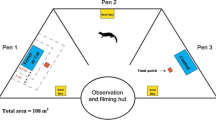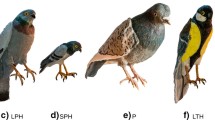Abstract
We compared the feeding behaviour of garden birds in the presence of four heterospecific decoy species at suburban feeding stations to assess the relative importance of body size (large vs. small) and demeanour (high vs. low potential for inter-specific aggression) as cues for threat recognition. We conducted separate trials with live, caged Australian magpie, Cracticus tibicen, and common myna, Acridotheres tristis, large and small species known to chase and harass heterospecifics, and comparably sized species not known for inter-species aggression (i.e. rock dove, Columba livia, and ringneck dove, Streptopelia risoria). Birds of all species arrived at feeding stations sooner and displayed higher-risk activities in the presence of small decoys. The two most common species that visited the feeding stations, silvereye, Zosterops lateralis, and house sparrow, Passer domesticus, were most likely to perform high-risk behaviours (i.e. landing on the stimulus cage and feeding from the station) in the presence of common mynas. The activities were performed least frequently in the presence of Australian magpies. As garden birds likely had the most experience interacting with common mynas, the results suggest that a two-step decision rule, with size and familiarity as important cues, may be used to recognize potential threats.



Similar content being viewed by others
References
Alatalo R, Moreno J (1987) Body size, interspecific interactions, and use of foraging sites in Tits (Paridae). Ecology 68:1773–1777
Barrington J (1995) Magpies—a black and white issue. Bird Mag 275:4
Barrington J (1996) Waikato magpie wars. Bird Mag 281:32–35
Carothers JH (1986) Behavioral and ecological correlates of interference competition among some Hawaiian Drepanidinae. Auk 103:564–574
Cockrem J, Silverin B (2002) Sight of a predator can stimulate a corticosteroid response in the Great Tit. Gen Comp Endocrinol 125:248–255
Cresswell W (2008) Non-lethal effects of predation in birds. Ibis 150:3–17
Crisp H, Lill A (2006) City slickers: habitat use and foraging in urban common mynas Acridotheres tristis. Corella 30:9–15
Curio E (1975) The functional organization of anti-predator behaviour. Anim Behav 23:1–115
Curio E (1993) Proximate and developmental aspects of antipredator behavior. Adv Study Behav 22
Day T (1995) Bird species composition and abundance in relation to native plants in urban gardens, Hamilton, New Zealand. Notornis 42:175–186
Edelaar P, Wright J (2006) Potential prey make excellent ornithologists: adaptive flexible responses towards avian predation threat by Arabian Babblers Turdoides squamiceps living at a migratory hotspot. Ibis 148:664–671
Evans C, Macedonia J, Marler P (1993) Effects of apparent size and speed on the response of Chickens, Gallus gallus, to computer-generated simulations of aerial predators. Anim Behav 46:1–11
Fisler G (1977) Interspecific hierarchy at an artificial food source. Anim Behav 25:240–244
Forsman J, Monkkonen M, Helle P, Inkeroines J (1998) Heterspecific attraction and food resources in migrants’ breeding patch selection in northern boreal forest. Oecologia 115:278–286
French A, Smith T (2005) Importance of body size in determining hierarchies among diverse tropical frugivores. Biotropica 37:96–102
Galloway D (1972) An alternative to mobbing as a measure of predator recognition. Brit Birds 65:522–526
Gill SA, Sealy SG (2008) Do hosts discriminate between sexually dichromatic male and female brown-headed cowbirds? Ethology 114:548–556
Gill S, Neudorf D, Sealy S (1997) Host responses to cowbirds near the nest: cues for recognition. Anim Behav 53:1287–1293
Greenberg R, Reitsma R, Cruz Angon A (1996) Interspecific aggression by yellow warblers in a sun coffee plantation. Condor 98:640–642
Hartley P (1950) Experimental analysis of interspecific recognition. Symp Soc Exp Biol 1950:313–336
Heather BD, Robertson HA (1996) A field guide to the birds of New Zealand. Viking, Auckland
Honza M, Grim T, Miroslav C, Moksnes A, Roskaft E (2004) Nest defense, enemy recognition and nest inspection behaviour of experimentally parasitized Reed Warblers Acrocephalus scirpaceus. Bird Study 51:256–263
Hromada M, Antczak M, Valone TJ, Tryjanowski P (2008) Settling decisions and heterospecific social information use in shrikes. PLoS One 3:e3930
Johnson CA, Giraldeau L-A, Grant JWA (2006) Intensity of interference affects the distribution of house sparrows, Passer domesticus, at food patches. Anim Behav 71:965–970
Knight RL, Temple SA (1986) Methodological problems in studies of avian nest defence. Anim Behav 34:561–566
Lee SD, Jablonski PG, Higuchi H (2007) Effect of heterospecifics on foraging of endangered red-crowned and white-naped cranes in the Korean demilitarized zone. Ecol Res 22:635–640
Liebert A, Starks P (2004) The action component of recognition systems: a focus on the response. Ann Zool Fenn 41:747–764
Maynard Smith J, Brown R (1986) Competition and body size. Theor Popul Biol 30:166–179
McLean I, Rhodes G (1991) Enemy recognition and response in birds. Curr Ornithol 8:173–211
Melvin J, Cloar F (1969) Habituation of responses of quail, Colinus virginianus, to a hawk, Buteo swainsoni: measurement through an ‘innate suppression’ technique. Anim Behav 17:468–473
Morgan D, Waas J, Innes J (2005) Magpie interactions with other birds in New Zealand: results from a literature review and public survey. Notornis 52:61–74
Morgan D, Waas J, Innes J (2006) Do territorial and non-breeding Australian Magpies Gymnorhina tibicen influence the local movements of rural birds in New Zealand? Ibis 148:330–342
Parejo D, Danchin E, Aviles JM (2004) The heterospecific habitat copying hypothesis: can competitors indicate habitat quality? Behav Ecol 16:96–105
Parker GA (1974) Assessment strategy and the evolution of fighting behaviour. J Theor Biol 47:223–243
Parsons H, Major R, French K (2006) Species interactions and habitat associations of birds inhabiting urban areas of Sydney, Australia. Austral Ecol 31:217–227
Pell A, Tidemann C (1997) The impact of two exotic hollow-nesting birds on two native parrots in savannah and woodlands in eastern Australia. Biol Conserv 79:145–153
Persson L (1985) Asymmetrical competition: are larger animals competitively superior? Am Nat 126:261–266
Robinson SK, Terborgh J (1995) Interspecific aggression and habitat selection by Amazonian birds. J Anim Ecol 64:1–11
Roell A, Bossema I (1982) A comparison of nest defence by jackdaws, rooks, magpies and crows. Behav Ecol Sociobiol 11:1–6
Schoener TW (1983) Field experiments on interspecific competition. Am Nat 122:240–285
Shealer DA, Burger J (1992) Differential respponses of tropical roseate terns to aerial intruders throughout the nesting cycle. Condor 94:712–719
Shelley E, Tanaka M, Ratnathcam R, Blumstein D (2004) Can Lanchester’s laws help explain interspecific dominance in birds? Condor 106:395–399
Sherman P, Hudson R, Pfennig D (1997) Recognition systems. In: Krebs J, Davies N (eds) Behavioural ecology: an evolutionary approach. Blackwell Science, London, pp 69–96
Starks P (2004) Recognition systems: from components to conservation. Ann Zool Fenn 41:689–690
Strausberger BM, Horning ME (1998) Responses of nesting song sparrows (Melospiza melodia) and red-winged blackbirds (Agelaius phoeniceus) to models of parasitic cowbirds and nonthreatening towhees. Bird Behav 12:71–78
Tindall D (1996) Ecological impacts and management of the common myna Acridotheres tristis. M.Sc. University of Auckland, Auckland
Wiebe K (2004) Innate and learned components of defence by flickers against a novel nest competitor, the European Starling. Ethology 110:779–791
Wilson D (1975) The adequacy of body size as a niche difference. Am Nat 109:769–784
Acknowledgments
We would like to thank: Bruce Patty for endless technical support and assistance; Hamilton land owners for volunteering their gardens and farms and assisting with pre-feeding and bird trapping; David Duganzich for volunteering statistical advice and assistance; and Fulbright New Zealand, the University of Waikato, and the Foundation for Research Science and Technology (contract UOWX0501 “Urban Restoration”) for funding the project.
Author information
Authors and Affiliations
Corresponding author
About this article
Cite this article
Borowske, A., Morgan, D.K.J. & Waas, J.R. Do heterospecific size and demeanour influence visitation behaviour of birds at urban foraging patches?. J Ethol 30, 75–82 (2012). https://doi.org/10.1007/s10164-011-0297-6
Received:
Accepted:
Published:
Issue Date:
DOI: https://doi.org/10.1007/s10164-011-0297-6




